Chromatophores
Introduction
The ability of certain marine animals to change color is a captivating natural phenomenon and product of advanced evolution driven by unique skin cells called chromatophores. Chromatophores are cells or organs that have the ability to disperse and concentrate pigments, changing the color of the skin barrier. [1] Radial muscle fibers attached to pigment sacs within the cell respond to nerve signals. The expansion and contraction of these muscles open and close the pigment sacs.[2] Chromatophores are classified based on their hue when analyzed under white light. These distinctions include erythrophores (red), cyanophores (blue), melanophores (black/brown), xanthophores (yellow), and leucophores (white). Additionally, iridophores, another type of chromatophore, reflect light at different wavelengths to further broaden the color changing abilities of the organism.
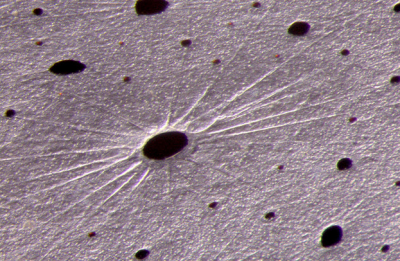

radial muscle fibers surrounding pigment sacs responsible for
chromatophore color change[3]
This adaptation is common among cephalopods, crustaceans, and cold-blooded vertebrates. This includes reef-dwelling organisms such as octopus, squid, hogfish, flounder, and more. Chromatophores can have a range of control mechanisms depending on the purpose and species. Two of the most common regulatory mechanisms include neural control and hormonal control. The evolutionary benefits of chromatophores are extensive. Vulnerable soft-bellied organisms, like octopus, squid, and cuttlefish, can avoid predators by blending into their environment in a matter of milliseconds.[2] Flounder, on the other hand, uses camouflage as a method of ambushing its prey. Many reef fish also use color change as a form of communication. During mating season, males will often transition to a breeding coloration pattern recognizable to females.[4] Reef fish will also darken their appearance when approaching cleaning stations to signal to the shrimp that they would like to be cleaned.[5]
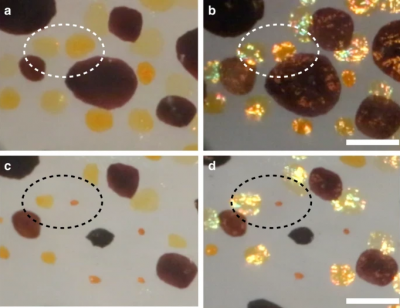

Specular reflection from chromatophores[6]
Hogfish
Hogfish (Lachnolaimus maximus) are vibrant residents of the North Atlantic Ocean, Gulf of Mexico, and the Caribbean Sea. Recognizable by its elongated snout and distinctive coloration, the hogfish is not only prized in sport fishing but also valued for its culinary qualities. Something that separates the hogfish from other marine species is that this fish has the remarkable ability to change its coloration in a fraction of a second! This trait is used for camouflage, communication, and social interactions, making the hogfish a fascinating subject of marine studies. Understanding the mechanics and abilities of the hogfish's ability to change color can provide us with a more nuanced understanding of the role that color has in marine environments.


Dynamic Color Change of Hogfish[7]
It's understood that chromatophores, specialized cells containing pigment, are responsible for the hogfish's color changing capabilities. When the hogfish wants to change its color, certain signals are sent from the brain to the chromatophores, triggering them to either expand or contract. This movement alters the distribution of pigment within the cells, resulting in a change in the color and pattern of the fish's skin. But how can a hogfish know if its skin is the proper color to blend in with the background without the ability to visualize or perceive its own skin with its eyes?
Hogfish have developed a unique mechanism that allows them to sense and regulate color without using their eyes. This is made possible by light-sensitive proteins called opsins.[8] Opsins are usually found in the eyes of many organisms but can also be found in the skin of hogfish, situated right below chromatophores. When light passes into a hogfish's skin, it must first pass through a chromatophore before it gets to the light-detecting opsin. This arrangement essentially takes a picture of the skin, allowing a hogfish to adjust the dispersion or concentration of pigment granules within its chromatophores, ensuring effective camouflage.[7] Essentially, through the collaboration of opsins and chromatophores, the hogfish's skin can "see" its own color changes, providing real-time feedback and enabling the fish to adjust its coloration precisely to blend into its surroundings.
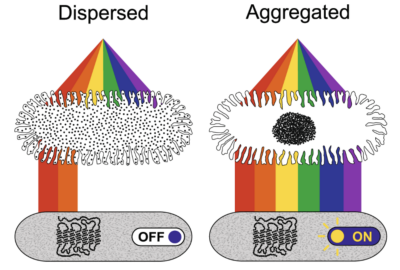

Aggregated pigments in chromatophore permit activation of opsin
SWS1[8]
Dermal photoreception, skin's ability to sense light through opsins proteins, and chromatophore skin cells are how Hogfish accomplish rapid color changes. Chromatophore skin cells control the skin's appearance and pigmentation. Dermal photoreception allows Hogfish to detect light from its skin independently from its eyes.[8] The hogfish's ability to change its appearance in a fraction of a second gives it a multitude of advantages for life in the reef such as camouflage, mating, and social interactions. Camouflage allows the Hogfish to match its environment. This trait is used as a skill to either avoid predators or ambush prey. Their dynamic color changes allow them to blend into reef backgrounds to disappear into their surrounding environments and out of the eye of predators. Hogfish also use color change to approach prey without being detected. This serves as a valuable strategy for increasing their hunting success. Additionally, color change either attracts Hogfish to or hides them from social and mating interactions in the reef. Dominant males can use bright colors to attract females and assert dominance. Vibrant colors are a signal of health that aids mating success. Subordinate males, however, present in duller colors to avoid confrontation with opposing males. This color pallet helps them stay out of sight and reduces the risk of social encounters.
Octopus
Chromatophores in cephalopods, such as octopuses and squids, differ strongly from those in other animals. Unlike the hormonally-controlled chromatophores of other fish, in cephalopods, they are neuromuscular organs that comprise a complex motor system.[9] Each chromatophore has a pigment-filled elastic sac surrounded with radial muscle fibers. When these muscle fibers, directly innervated by the brain, contract, the pigment spreads and changes the color of the skin.[10]
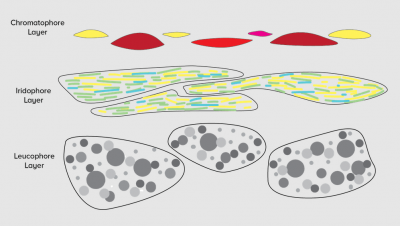

Illustration by Ariel Zych depicting the multi-layered cephalopod skin,
allowing for their impressive camouflage abilities.[11]
The nervous system of octopuses thus plays a crucial role in the regulation and control of chromatophores. The central nervous system of cephalopods is incredibly advanced for invertebrates. Consequently, the structural and functional organization of cephalopod brains has been studied extensively. Three hierarchical levels of neural control of chromatophores have been identified in octopuses. At the lowest level, the four chromatophore lobes contain the chromatophore motoneurons, innervating the muscle fibers surrounding chromatophores throughout the body. These lobes receive input from the next level, the lateral basal lobes, which receive input from the highest level, the optic lobes. The optic lobes process visual input, which is the primary stimulus for chromatophore activation. The hierarchical organization allows for the brain to process visual stimuli rapidly and produce color changes accordingly .[9]
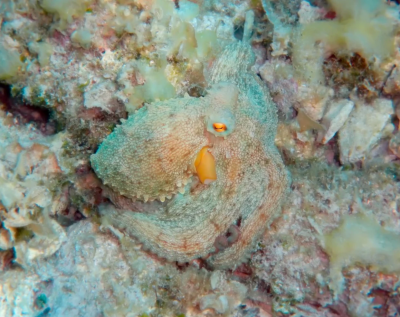

Mediterranean octopus camouflaging to its surrounding.[12]
Like many other organisms, octopuses use chromatophores for multiple purposes. One of the primary uses of chromatophores is for camouflage. Despite only having one kind of photoreceptor, and thus seeing only in black-and-white, octopuses are experts at concealment in both color and texture. It is believed that the leucophores, which are broad-band receptors of light, enable the color-matching abilities of color-blind octopuses. Octopuses typically hunt at night as ambush predators. They lay in hiding and then ambush their prey, injecting their venom with their hard beaks. Thus, their advanced camouflage capabilities are vital for them to effectively hunt prey .[9]
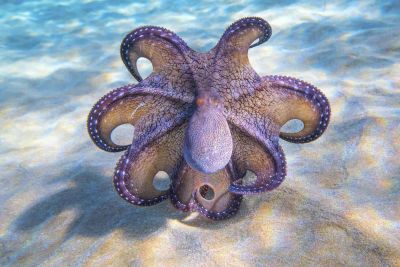

An octopus displaying deimatic behavior, darkening the edges of its arms
and body while lightening its head.[13]
Furthermore, octopuses use their color-changing abilities for communication, both intra- and inter-specifically. Like many other animals with chromatophores, octopuses use intraspecific displays, or those between members of the same species, to signal competence in mating and fighting ability. However, given the apparent intelligence and complexity of octopuses and other cephalopods, the extent of intraspecific communication is not yet fully understood. Octopuses, and other cephalopods, also commonly use chromatophores to signal to prey or predators. One remarkable display that can be seen in the different kinds of cephalopods is known as deimatic behavior. A deimatic display in a cephalopod involves the changing of physical aspects to appear much larger in size, including spreading and flattening out, creating intense dark spots around the eyes, and paling itself while darkening the edges of its body.[9]
Conclusion
Chromatophores give octopus and hogfish the fascinating ability to change colors, benefiting them in their natural environments when hunting prey, communicating with other species, and finding mates. These advantages allow these species to quickly adapt to their environment keeping population size up and giving them their distinct role in the reef ecosystems. The concept of camouflage and color change is so thought-provoking that chromatophores have captured the attention of a group of scientists working at the University of Pennsylvania. By arranging the liquid crystals into helical shapes using thin flexible membranes, the team has been able to generate synthetic chromatophores that can change colors on command.[14] This preliminary research will pave the way toward advancements in biomimetic photonic devices and sensory technology with higher sensitivity and reaction times which could potentially be used as future military aid.
References
- [↑ Fingerman, M. (1963). Chromatophores of cephalopods. The Control of Chromatophores, 93–96. https://doi.org/10.1016/b978-0-08-009824-1.50009-5]{#cite_note-fingerman-1}
- [↑ 2.0 2.1 Gilmore, R. (2016). Cephalopod Camouflage: Cells and Organs of the Skin. Nature news. https://www.nature.com/scitable/topicpage/cephalopod-camouflage-cells-and-organs-of-the-144048968/]{#cite_note-gilmore-2}
- [↑ [1]]{#cite_note-nature-3}
- [↑ . McGrouther, A. M. (2020, March 26). Fish FAQ - can fishes change colour?. The Australian Museum. https://australian.museum/learn/animals/fishes/can-fishes-change-colour/#:~:text=Rapid%20colour%20changes%20]{#cite_note-mcgrouther-4}
- [↑ Caves, E. M. (2021). The behavioural ecology of marine cleaning mutualisms. Biological Reviews, 96(6), 2584–2601. https://doi.org/10.1111/brv.12770]{#cite_note-caves-5}
- [↑ https://www.nature.com/articles/s41467-019-08891-x]{#cite_note-nature2-6}
- [↑ 7.0 7.1 Carmichael, Stephen W. "How a Fish Can 'See' with Its Skin." Microscopy Today, vol. 32, no. 1, Oxford University Press, Jan. 2024, pp. 8–9, https://doi.org/10.1093/mictod/qaad101. Accessed 31 May 2024.]{#cite_note-carmichael-7}
- [↑ 8.0 8.1 8.2 Schweikert, Lorian E., et al. “Dynamic Light Filtering over Dermal Opsin as a Sensory Feedback System in Fish Color Change.” Nature Communications, vol. 14, no. 1, Nature Portfolio, Aug. 2023, https://doi.org/10.1038/s41467-023-40166-4. Accessed 31 May 2024.]{#cite_note-schweikert-8}
- [↑ 9.0 9.1 9.2 9.3 Messenger, J. B. (2001). Cephalopod chromatophores: neurobiology and natural history. Biological Reviews, 76, 473-528. https://doi-org.libproxy.lib.unc.edu/10.1017/S1464793101005772]{#cite_note-messenger-9}
- [↑ Mäthger, L. M., Denton, E. J., Marshall, N. J., & Hanlon, R. T. (2009). Mechanisms and behavioural functions of structural coloration in cephalopods. Journal of the Royal Society, Interface, 6(2), S149–S163. https://doi.org/10.1098/rsif.2008.0366.focus]{#cite_note-mathger-10}
- [↑ [2]]{#cite_note-sf-11}
- [↑ [3]]{#cite_note-med-12}
- [↑ [4]]{#cite_note-octonation-13}
- [↑ Lerner, E. (2021, September 14). Penn Engineering’s artificial chromatophores enable surfaces with squid-like active camouflage. Penn Engineering Blog. https://blog.seas.upenn.edu/penn-engineerings-artificial-chromatophores-enable-surfaces-with-squid-like-active-camouflage/#:~:text=Using%20thin%2C%20flexible%20membranes%20made,visible%20to%20ultraviolet%20—%20on%20command]{#cite_note-lerner-14}